Storing carrots in winter: the best varieties with excellent keeping quality
Damage to carrots storage - a common problem for many summer residents. The reasons for this phenomenon are an incorrectly chosen variety, poor ventilation and high temperature in the room, and damage by pathogens.
From the article you will learn how to choose a variety with improved shelf life and how to store carrots in winter.
Features of storing carrots in winter
For better storage of carrots in winter, follow the harvesting rules: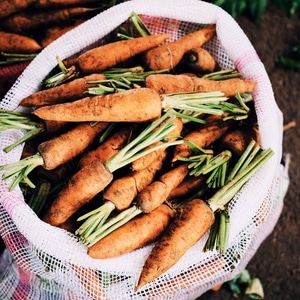
- cleaning time;
- drying;
- rejection of diseased specimens.
After harvesting the root crop, the tops are cut off, the vegetable is dried and placed in a specially prepared place.
Features of storing carrots:
- temperature - from 0 to +3°C;
- humidity - 90%;
- good ventilation;
- no damage or signs of disease on the vegetable.
Carrots and apples are not recommended to be stored nearby. The latter emit ethylene, which causes spoilage of the root crop.
Long-term storage methods
The vegetable is stored in the cellar or basement, on the balcony or in the refrigerator.
Important! The main thing is to ensure that the storage location does not freeze.
To preserve carrots for a long time, use:
- Wooden box. It should be well ventilated. Place the container at a distance of 10 cm from the wall and do not place it on the floor.
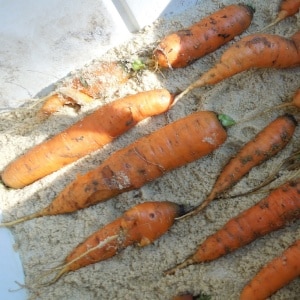
- Bulk method. Vegetables are stacked on top of each other up to 2 m in height. Choose a well-ventilated area.
- Onion peel. Onion peels and carrots are placed in bags. This will protect the vegetable from rotting, and the husk will absorb excess moisture.
- Sawdust pine needles. Use any container. Lay sawdust and vegetables in layers. This will rid the carrots of excess moisture and prevent harmful microorganisms from spreading.
- Sand. Pour a small layer of sand into a container or on a shelf. Place the vegetable and cover it with another layer of sand. This procedure is repeated several times, placing layers on top of each other. Recommended height: up to 1 m.
- Plastic bags. The dry vegetable is placed in a bag and left on a shelf in a storage area. It is not recommended to tie the bag.
Non-traditional storage methods:
- Using chalk or clay mortar. Chalk or clay is dissolved in water until liquid. The vegetable is soaked in this solution, dried and stored.
- Using moss. Root vegetables are placed in a container and surrounded on all sides with moss. It will absorb excess moisture, which will prevent diseases.
- Storage in beds. After the vegetable ripens, it is not dug up, but left in the garden, cutting off only the tops. Then they are carefully insulated so that winter frosts do not destroy the crop, and they are left like that until spring.
- In a refrigerator. Whole root vegetables are placed in bags and stored in the fruit compartment. Or they make vegetable preparations by chopping them on a coarse grater. The resulting mass is placed in a bag and sent to the freezer.
Before sending carrots to the basement or cellar, you must:
- clean the premises;
- disinfect the storage area with lime or copper sulfate solution.
Varieties and hybrids for long-term storage
Late varieties best suited for storage.The later the carrots ripen, the longer they will last in the winter and retain all their beneficial properties. As a rule, late varieties are harvested in the autumn.
The following varieties are used for winter storage:
- Valeria, or Flakke. This variety of carrots is classified as late-ripening in terms of ripening. The root crop is cone-shaped, length up to 250 mm, weight up to 500 g. Productivity 2-6 kg/m². Doesn't shoot.
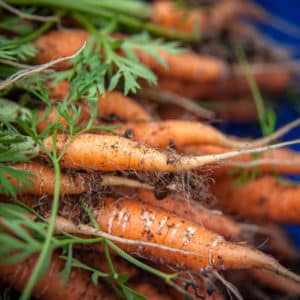
- Queen of Autumn. Late ripening period. The length of the root crop is 200-300 mm, weight up to 250 g. Productivity up to 9 kg/m². Does not crack. Resistant to shooting.
- Red giant. Ripening period is 150 days. Cone-shaped root crop. Length up to 240 mm. Weight 80-140 g. Productivity 2-4 kg/m². Resistant to frost.
- Olympus. The growing season is late. The shape is conical, smooth. Carrot length is up to 240 mm. Weight 70-130 g. Productivity 6 kg/m². High taste qualities.
- Sweet winter. Ripening time is 140-150 days. Root length 300 mm, weight 200 g. Productivity up to 8 kg/m². High taste qualities.
- Typhoon. Mid-season hybrid. Cone-shaped root crop. Size up to 200 mm. Weight 80-145 g. Productivity 2-3.5 kg/m². Resistant to fungal diseases.
- Flaccoro. According to the ripening period, it belongs to the mid-season species. The shape is elongated-conical. The length of the root crop is up to 280 mm. Weight 200-400 g. Productivity 9-10 kg/m². High level of shelf life, does not crack.
- Tsirano. The ripening period is average. Root crop of regular shape. Size up to 150 mm. Weight 60-135 g. Productivity 3-6 kg/m².
Do not store early-ripening carrot varieties for long-term storage.
Characteristics of winter types of carrots
Growing winter carrots is a less common method among summer residents.
Advantages of sowing crops in winter:
- shortened ripening period;
- friendly shoots in the spring;
- hardened crops;
- high-quality harvest and excellent presentation.
Winter varieties do not last long.
Varieties of carrots that can overwinter in the ground
To successfully grow root crops in winter, choose frost-resistant hybrids with high germination rates.
Varieties of carrots that can overwinter in the ground:
- Nantes 4. The growing season is 90 days. Length up to 180 mm, weight 170 g. Productivity 5 kg/m².

- Incomparable. Ripening period is 114 days. Size up to 170 mm, weight 200 g. Productivity 7 kg/m².
- Losinoostrovskaya 13. Ripening period 110 days. Length 150 mm, weight 100 g. Productivity 8 kg/m².
- Vitamin. The growing season is 90 days. Length 180 mm, weight 160 g. Productivity 10 kg/m².
- Chantenay 2461. Growing season 90-130 days. Size up to 170 mm, weight 110 g. Productivity up to 10 kg/m².
- Moscow winter. Ripening period is 125 days. Length up to 170 mm, weight 150 g. Productivity 7 kg/m².
Description of the best varieties of carrots for winter storage
The main features of the variety that people pay attention to:
- growing season more than 120 days;
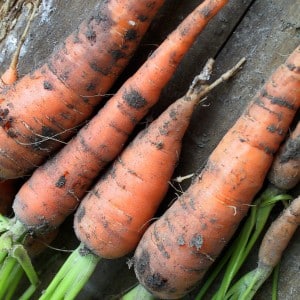
- does not crack or flake;
- grown in different climatic conditions;
- not exposed to disease.
Early
Early varieties include plants with a ripening period of up to 100 days:
- Touchon. Root crop of regular shape. Length up to 150 mm, weight 100 g. Productivity 5 kg/m².
- Artek. Unpretentious. Weight 120 g, size 150 mm. Productivity 4-6 kg/m². Resistant to white rot, but prone to gray rot.
- Fun F1. The root crop is cylindrical in shape. Length up to 170 mm, weight up to 100 g. High-yielding hybrid - up to 7 kg/m². Does not crack or shoot.
Mid-season
The ripening period for mid-season varieties is 100-120 days:
- Samson. Large carrots. Length up to 200 mm, weight up to 170 g. Productivity 5-7 kg/m².
- Chance. The root crop is smooth, regular in shape. Length 160 mm, weight up to 200 g. Productivity 3-5 kg/m². Doesn't shoot.
- Solomon F1. The root vegetable is bright orange in color. Size up to 250 mm, weight up to 300 g. High-yielding hybrid - up to 4 kg/m².
Late
Late varieties include vegetables with a ripening period of more than 120 days.
Advantages of late carrot varieties: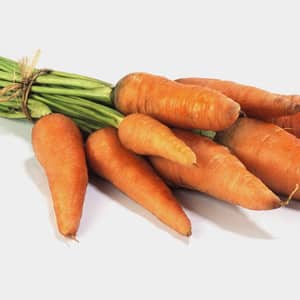
- long shelf life of the root crop;
- high ripening of carrots;
- resistance to bolting and diseases.
Productive varieties:
- Queen of Autumn. The root crop is smooth, cylindrical in shape. Size up to 220 mm, weight 120-130 g. Productivity up to 9 kg/m².
- Flaccoro. Large, smooth root vegetables. Size up to 280 mm, weight up to 200 g. Productivity over 8 kg/m².
- Karotan RZ. Vegetable of regular shape. Length 250 mm, weight up to 150 g. Productivity 4-6 kg/m².
Large

Large varieties of carrots are high-yielding and have a long shelf life.
- Canada F1. Conical root crop. Ripening is late. The length of the root crop is 20-30 cm. Weight is up to 170 g. High-yielding hybrid - up to 8 kg/m².
- Russian size. The growing season is 120-130 days. The root vegetable is bright orange in color. Size up to 300 mm. Weight up to 1000 g. Productivity - up to 8 kg/m².
- Nandrin F1. Early ripening. The length of the root crop is up to 250 mm. Weight up to 300 g. High-yielding hybrid - up to 8 kg/m². The hybrid does not crack, is resistant to diseases and bolting.
Sweet
I use sweet varieties of carrots for baby food. Due to its high carotene content, the vegetable is especially beneficial for children's bodies: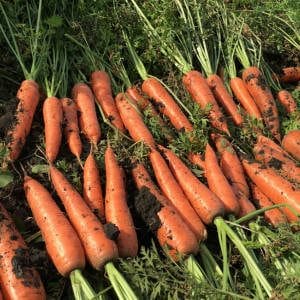
- Darling. Early variety. Root crops of regular shape, up to 160 mm long, weighing 160 g. Productivity up to 6.5 kg/m². Doesn't shoot.
- Emperor. The growing season is 120-135 days. Size 25-30 cm. Weight up to 120 g. Productivity 2-4 kg/m².
- Dolyanka. Late variety. The root crop is conical in shape, up to 300 mm in size, weighing up to 140 g. Productivity - 2-3 kg/m². Resistant to fusarium and carrot fly.
- Sugar fingers. Ultra early ripening appearance. Root crops are smooth, cylindrical in shape. Weight 100 g. Length up to 120 mm. Productivity 4-5 kg/m². Resistant to bolting, cracking and putrefactive diseases of the crop.
Conclusion
For the best result, proper care and creating optimal conditions in the cellar are not enough - it is important to take a responsible approach to choosing the variety. Now you know which carrots are best suited for planting and long-term storage.
Pay attention to resistance to disease, bolting and cracking. For long-term storage, choose medium or late varieties. If all recommendations are followed, the root vegetable will last for more than six months and retain all its beneficial properties.